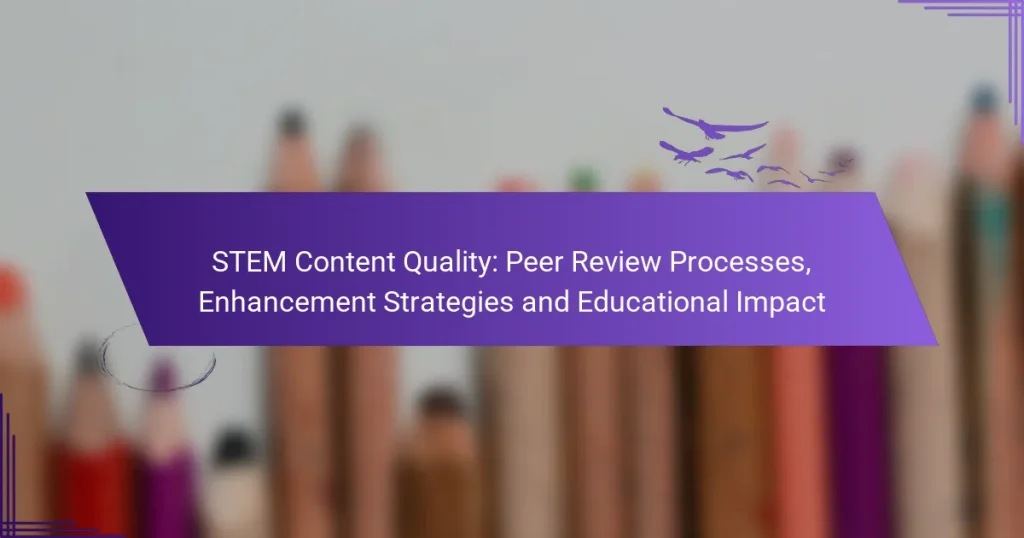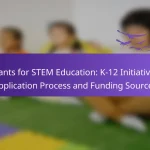The peer review process plays a crucial role in enhancing the quality of STEM content by subjecting research to rigorous evaluation by field experts. This not only validates findings but also cultivates a culture of accountability and continuous improvement. By implementing effective enhancement strategies, such as incorporating diverse perspectives and utilizing technology, the relevance and quality of educational materials can be significantly improved, ultimately benefiting students and fostering a collaborative learning environment.
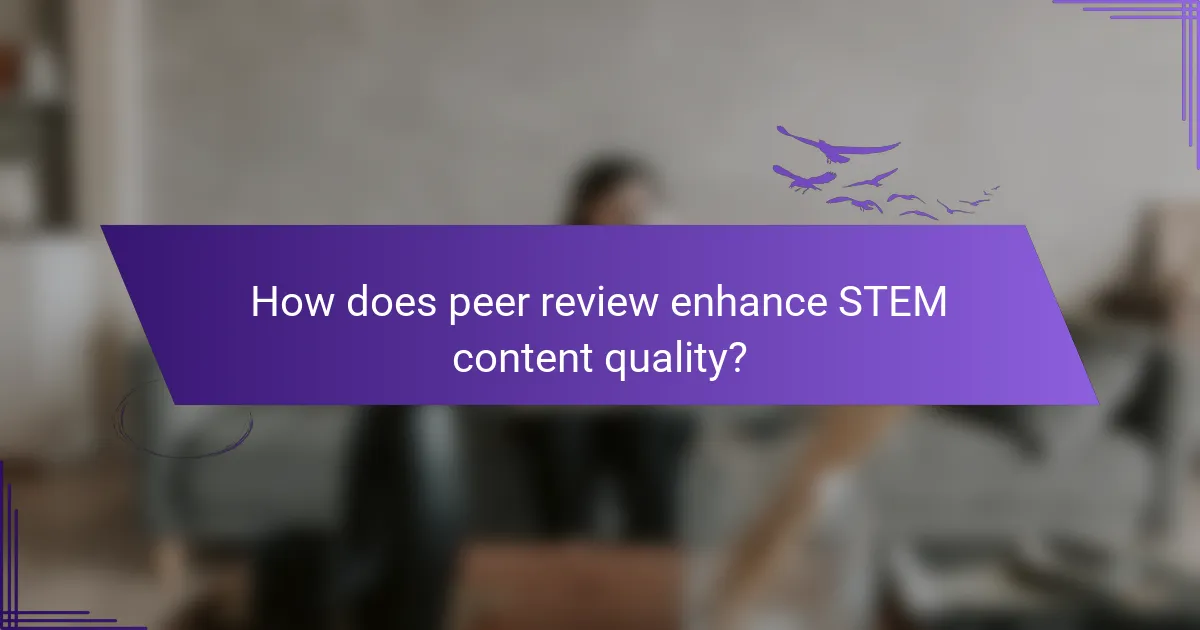
How does peer review enhance STEM content quality?
Peer review significantly enhances the quality of STEM content by ensuring that research is rigorously evaluated by experts in the field before publication. This process not only improves the validity of findings but also fosters a culture of accountability and continuous improvement in scientific communication.
Improves credibility and reliability
Peer review enhances the credibility of STEM content by subjecting it to scrutiny from knowledgeable peers. When research is vetted by experts, it assures readers that the findings are based on sound methodology and accurate data.
This reliability is crucial in STEM fields, where the implications of research can impact public policy, health, and technology. For instance, studies that undergo peer review are often more trusted by funding bodies and regulatory agencies, which can lead to increased support and implementation of findings.
Facilitates constructive feedback
The peer review process provides authors with valuable feedback that can improve their work. Reviewers often highlight strengths and weaknesses, allowing researchers to refine their arguments, clarify their methodologies, and address potential biases.
Constructive criticism can lead to significant enhancements in the quality of the research. For example, a reviewer might suggest additional experiments or alternative interpretations of data, which can ultimately strengthen the final publication and its impact on the field.
Ensures adherence to academic standards
Peer review helps maintain high academic standards by ensuring that published work meets established criteria for quality and rigor. This process often involves checking for compliance with ethical guidelines, proper citation practices, and adherence to relevant scientific protocols.
By upholding these standards, peer review not only protects the integrity of individual studies but also contributes to the overall trustworthiness of scientific literature. Researchers are encouraged to familiarize themselves with the specific guidelines of their field to ensure their submissions meet these expectations.

What are effective enhancement strategies for STEM content?
Effective enhancement strategies for STEM content involve incorporating diverse perspectives, utilizing technology for content review, and implementing iterative feedback loops. These approaches aim to improve the quality and relevance of educational materials, ensuring they meet the needs of a broad audience.
Incorporating diverse perspectives
Incorporating diverse perspectives enriches STEM content by reflecting various cultural, gender, and socioeconomic viewpoints. This can be achieved by including contributions from underrepresented groups in the development process, which can lead to more relatable and comprehensive materials.
For instance, when creating a physics curriculum, integrating examples from different cultures can help students see the relevance of the subject in their own lives. Additionally, involving educators from diverse backgrounds in the review process can highlight potential biases and gaps in the content.
Utilizing technology for content review
Utilizing technology for content review enhances the efficiency and accuracy of the peer review process. Tools such as collaborative platforms and AI-driven content analysis can streamline feedback collection and help identify areas needing improvement.
For example, using cloud-based collaboration tools allows multiple reviewers to provide input simultaneously, reducing the time needed for revisions. Additionally, AI tools can analyze content for clarity and engagement, offering suggestions to enhance readability and effectiveness.
Implementing iterative feedback loops
Implementing iterative feedback loops ensures continuous improvement of STEM content through regular updates based on user input. This process involves collecting feedback from students and educators after each use, which can inform subsequent revisions and enhancements.
For effective implementation, establish a schedule for feedback collection, such as after each semester or module. This allows for timely adjustments and helps maintain the relevance of the content. Common pitfalls include neglecting to act on feedback or failing to involve all stakeholders in the review process, which can limit the effectiveness of the enhancements.
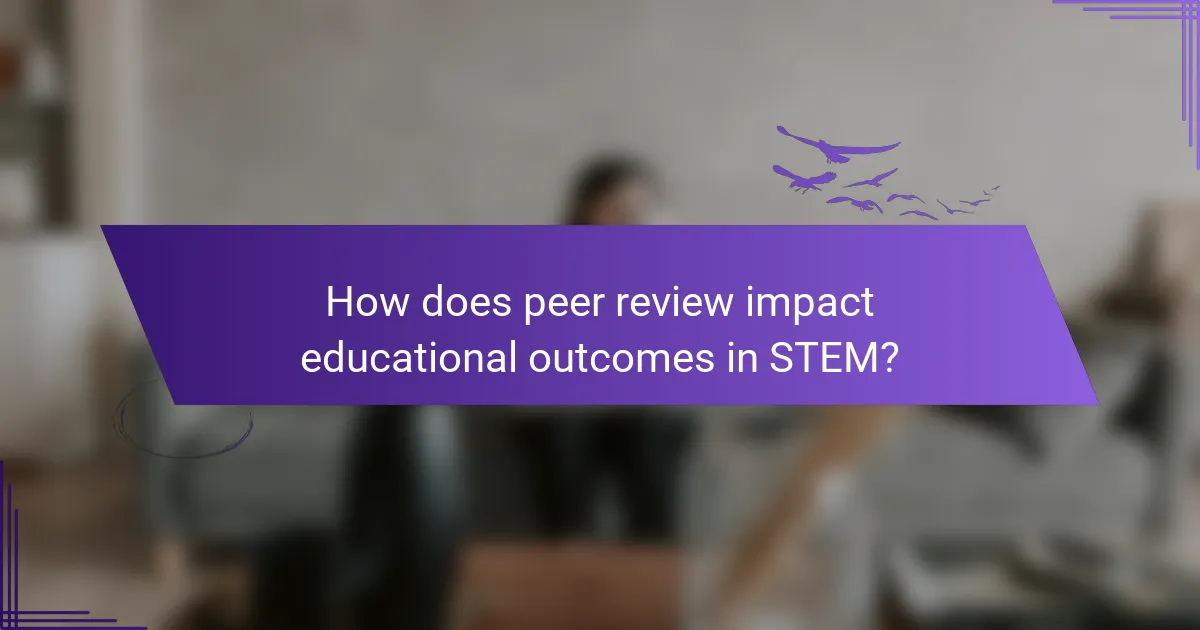
How does peer review impact educational outcomes in STEM?
Peer review significantly enhances educational outcomes in STEM by fostering a collaborative learning environment and promoting higher standards of academic rigor. Through this process, students engage with feedback that sharpens their understanding and application of scientific concepts.
Enhances student engagement
Peer review encourages active participation among students, making them more invested in their learning. When students critique each other’s work, they become more involved in the subject matter, leading to a deeper interest in STEM fields.
For example, group discussions around peer-reviewed projects can spark curiosity and motivation, as students see the relevance of their work to real-world problems. This engagement can be further amplified by incorporating technology, such as online platforms for collaborative reviews.
Improves critical thinking skills
Engaging in peer review cultivates critical thinking by requiring students to analyze and evaluate the work of their peers. This process helps them develop the ability to identify strengths and weaknesses in arguments, methodologies, and conclusions.
Students learn to ask probing questions and provide constructive feedback, which enhances their analytical skills. For instance, when reviewing a fellow student’s experiment, they must consider variables, controls, and potential biases, fostering a more rigorous scientific mindset.
Increases retention of knowledge
Peer review can lead to improved retention of knowledge as students actively engage with content through teaching and critique. When students explain concepts to their peers, they reinforce their own understanding and memory of the material.
Research suggests that teaching others can enhance retention rates significantly. For example, students who participate in peer review often recall concepts better than those who only study independently, as the act of reviewing requires them to revisit and articulate their knowledge. This method can be particularly effective in STEM subjects, where complex concepts benefit from collaborative exploration.

What are the prerequisites for a successful peer review process?
A successful peer review process relies on clear guidelines and the involvement of qualified reviewers. These elements ensure that the evaluation of STEM content is thorough, consistent, and constructive, ultimately enhancing the quality of published work.
Clear guidelines and criteria
Establishing clear guidelines and criteria is essential for a successful peer review process. These guidelines should outline the expectations for reviewers, including the aspects of the work to evaluate, such as methodology, significance, and originality.
Providing a checklist or rubric can help reviewers focus on key elements and streamline their assessments. For instance, criteria might include clarity of presentation, appropriateness of the research design, and relevance to current scientific discourse.
Qualified reviewers with relevant expertise
Engaging qualified reviewers with relevant expertise is crucial for effective peer review. Reviewers should possess a deep understanding of the subject matter and familiarity with current trends and challenges in the field.
When selecting reviewers, consider their publication history, professional affiliations, and any previous experience with peer review. This ensures that the feedback provided is not only informed but also constructive, helping authors improve their work significantly.
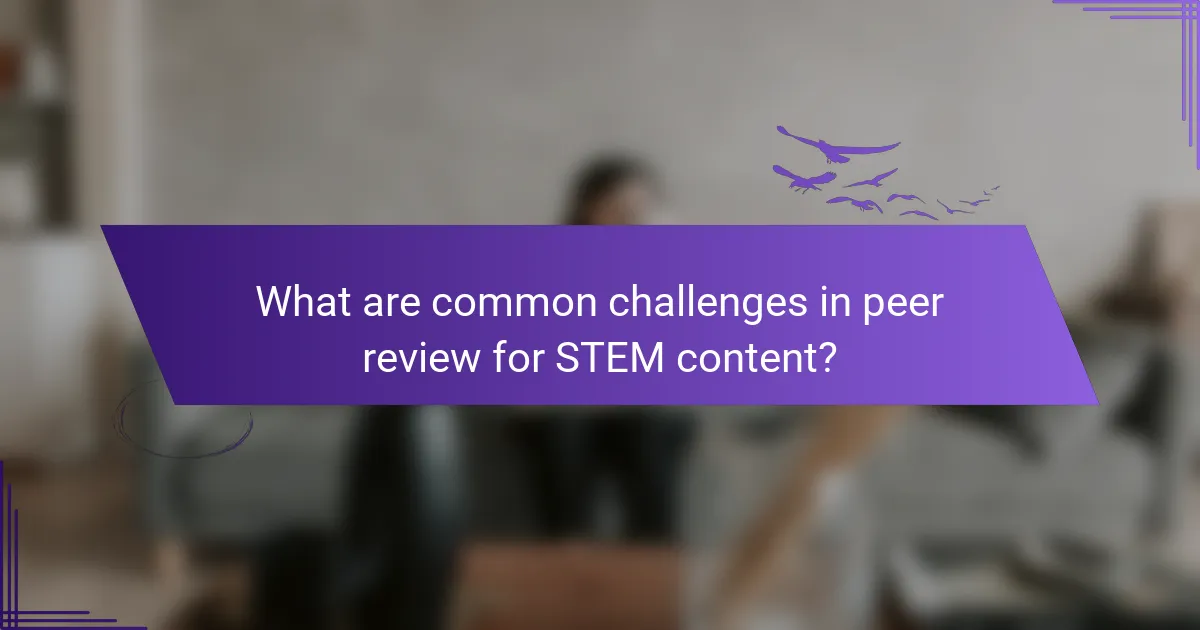
What are common challenges in peer review for STEM content?
Peer review in STEM fields faces several challenges that can impact the quality and efficiency of the process. Key issues include reviewer bias, time constraints, and a lack of standardization, all of which can hinder the objective evaluation of scientific work.
Reviewer bias and subjectivity
Reviewer bias occurs when personal beliefs or preferences influence the evaluation of a manuscript, leading to inconsistent assessments. This subjectivity can result in unfair rejections or approvals, affecting the integrity of the peer review process. For instance, a reviewer may favor certain methodologies or theoretical frameworks, which can skew their judgment.
To mitigate bias, journals can implement double-blind reviews, where both authors and reviewers remain anonymous. This approach can help reduce personal biases and promote a more equitable review process. Additionally, training reviewers on recognizing their biases can enhance objectivity.
Time constraints for reviewers
Time constraints are a significant challenge for reviewers, who often juggle multiple responsibilities, including research, teaching, and administrative duties. This can lead to rushed evaluations, potentially compromising the thoroughness of the review. Reviewers may have only a few weeks to assess a manuscript, which is often insufficient for complex STEM topics.
To address this issue, journals can offer flexible deadlines or incentivize timely reviews with recognition or rewards. Clear communication about expected time commitments can also help reviewers manage their workloads effectively.
Lack of standardization in review processes
The peer review process varies widely across journals and disciplines, leading to inconsistencies in how reviews are conducted. This lack of standardization can confuse authors and reviewers alike, making it difficult to understand expectations or criteria for evaluation. Different journals may have unique guidelines, which can complicate the submission process.
Establishing clear, standardized guidelines for peer review can enhance transparency and fairness. Journals could adopt best practices from established organizations or create a checklist for reviewers to ensure all critical aspects are covered. This would streamline the process and improve the overall quality of reviews in STEM fields.

How can online courses improve peer review practices?
Online courses can enhance peer review practices by incorporating structured feedback mechanisms and collaborative learning environments. These elements encourage critical thinking and provide students with valuable insights into their work while fostering a sense of community.
Integrating peer review in course design
Integrating peer review into course design involves creating assignments that specifically require students to evaluate each other’s work. This can be achieved by setting clear guidelines and expectations for the review process, ensuring that students understand the criteria they should use when assessing their peers.
Consider incorporating peer review at various stages of the course, such as drafts, final submissions, or project presentations. This approach allows for iterative feedback, helping students improve their work progressively and enhancing their learning experience.
Providing training for reviewers
Training for reviewers is essential to ensure that students can provide constructive and meaningful feedback. Workshops or instructional materials can help students understand the principles of effective peer review, including how to give balanced critiques and recognize strengths and weaknesses in their peers’ work.
Encouraging students to practice reviewing sample submissions before engaging in actual peer reviews can build their confidence and improve the quality of feedback they provide. This practice can also help them become more receptive to feedback on their own work.
Utilizing platforms like Peergrade
Platforms like Peergrade facilitate the peer review process by providing structured environments for students to submit their work and receive feedback. These tools often include features that allow for anonymous reviews, which can reduce bias and encourage honesty in critiques.
Using such platforms can streamline the logistics of peer review, making it easier for instructors to manage submissions and feedback. Additionally, they often provide analytics that can help educators assess the effectiveness of the peer review process and make necessary adjustments to improve learning outcomes.
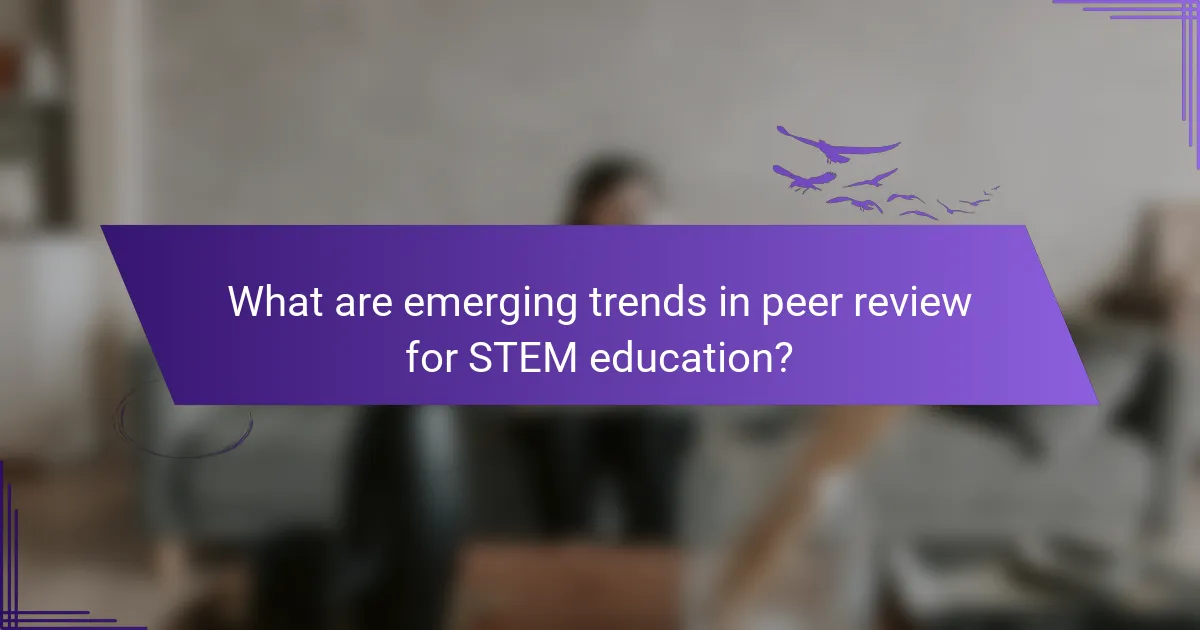
What are emerging trends in peer review for STEM education?
Emerging trends in peer review for STEM education focus on enhancing collaboration, transparency, and inclusivity in the review process. These trends aim to improve the quality of educational content and foster a more supportive environment for educators and researchers.
Open Peer Review
Open peer review is gaining traction as it promotes transparency by allowing reviewers’ identities to be known. This approach can enhance accountability and encourage more constructive feedback. Institutions are increasingly adopting this model to build trust in the review process.
For example, platforms like Publons and F1000Research facilitate open peer review, enabling authors to see reviewer comments and responses. This openness can lead to higher quality revisions and a more engaged academic community.
Collaborative Review Processes
Collaborative review processes involve multiple reviewers working together to assess educational materials. This trend encourages diverse perspectives, which can lead to richer feedback and more comprehensive evaluations. It also fosters a sense of community among educators.
Tools like Google Docs or collaborative platforms such as Overleaf allow reviewers to comment and suggest changes in real-time, making the process more efficient. Institutions should consider implementing these tools to streamline collaboration.
Focus on Inclusivity and Diversity
There is a growing emphasis on inclusivity and diversity in peer review, ensuring that a wide range of voices and experiences are represented. This trend is crucial for developing educational materials that are relevant and accessible to all students.
To promote inclusivity, peer review committees should include members from various backgrounds and disciplines. Training reviewers on cultural competency can also enhance the quality of feedback and support diverse educational needs.
Integration of Technology
Technology is transforming peer review processes in STEM education by automating aspects of the review and enhancing data analysis. Tools like AI-driven software can assist in identifying potential biases and ensuring adherence to standards.
For instance, platforms that utilize machine learning can help match reviewers with submissions based on expertise, improving the relevance of feedback. Educators should stay informed about these technological advancements to leverage their benefits effectively.
